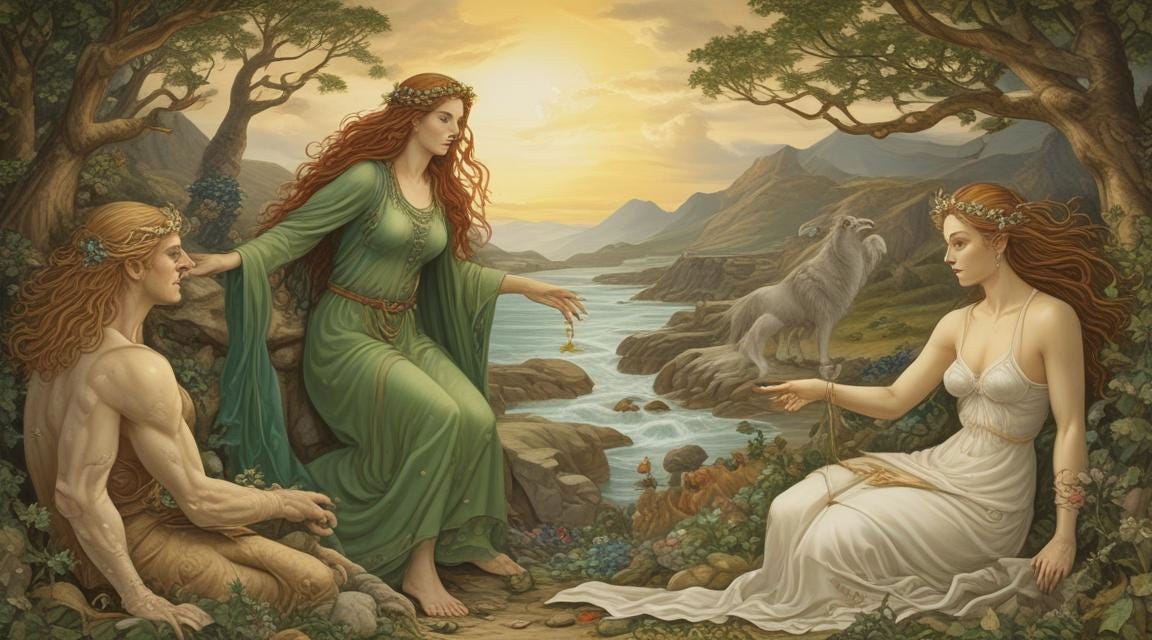The Tuatha Dé Danann (Irish: meaning "the folk of the goddess Danu"), also known by the earlier name Tuath Dé ("tribe of the gods") are a supernatural race in Irish mythology.
Tuathan Celtic Mythology
Welcome to the world of Tuathan Celtic mythology! From ancient gods to magical creatures, Tuathan Celtic mythology has long held a special place in the hearts and minds of many.
The Tuatha Dé Danann, a group of ancient gods and goddesses, are the primary focus of Tuathan Celtic mythology. These powerful deities are the subject of several myths, including tales of battles and quests for sovereignty. The Tuatha Dé Danann are also credited with many gifts to humanity, such as language and healing.
In addition to the gods and goddesses, a variety of magical creatures are part of the Tuathan Celtic mythology. From leprechauns and fairies to kelpies and pixies, these mythical creatures are believed to exist in a realm of their own. They are often found in the stories protecting their realm from evil forces and helping people in need.
The Tuathan Celtic mythology is also home to several notable figures. Several heroes and legendary figures feature in Tuathan Celtic mythology, including King Arthur, Cú Chulainn, and Finn MacCool. These heroes are seen as symbols of courage, strength, and wisdom.
The Tuathan Celtic mythology is an integral part of Irish culture and is celebrated in many forms today. From films to books, art music, Tuathan Celtic mythology has been the source of much inspiration.
Explore Tuathan Celtic Mythology
One of the best ways to explore Tuathan Celtic mythology is to delve into the myths and stories themselves. There are numerous books available that focus on the gods and goddesses, legendary figures, and magical creatures of the Tuathan Celtic mythology.
Reading these stories will give you a better understanding of the beliefs and values that are associated with this culture.
The Tuatha De Danann
he Tuatha Dé Danann were descended from Nemed, leader of a previous wave of inhabitants of Ireland. In other accounts, they are descended from Danu or Anu, a mother goddess.
They came from four cities to the north of Ireland—Falias, Gorias, Murias and Finias—where they taught their skills in the sciences, including architecture, the arts and magic.
According to Lebor Gabála Érenn, they came to Ireland "in dark clouds" and "landed on the mountains of [the] Conmaicne Reinin Connachta", otherwise Sliabh an Iarainn, "and they brought a darkness over the sun for three days and three nights".
They immediately burnt the ships "so that they should not think of retreating to them, and the smoke and the mist that came from the vessels filled the neighbouring land and air. Therefore it was conceived that they had arrived in clouds of mist".
The Tuatha Dé Danann brought four magical treasures with them to Ireland, one apiece from their Four Cities:
Dagda's Cauldron - No one ever went away from it unsatisfied
The Spear of Lugh - No battle was ever sustained against it or against the man who held it.
Lia Fáil (The Stone of Fal) - It would cry out beneath the king who took the sovereignty of Ireland.
Claíomh Solais (The Sword of Light) - No one ever escaped from it once it was drawn from its sheath, and no one could resist it. The sword is also described in the Tain legend as "Nuadu's Cainnel"—a glowing bright torch
Some key members of the Tuatha Dé Danann include:
Dagda: The father figure of the Tuatha Dé Danann, Dagda is often depicted as a powerful and wise god. He is associated with fertility, abundance, and magic.
Morrigan: A goddess of war, fate, and death, Morrigan is a complex figure in Tuathan Celtic mythology. She is said to appear as a crow on the battlefield, choosing who will live and who will die.
Brigid: A goddess of poetry, healing, and smithcraft, Brigid is a beloved figure in Tuathan Celtic mythology. She is often celebrated during the festival of Imbolc.
Lugh: A skilled warrior and craftsman, Lugh is known as a master of many arts. He is often seen as a hero and a protector of the Tuatha Dé Danann.
Aengus: A god of love, youth, and beauty, Aengus is associated with music and poetry. He is often depicted as a romantic figure in Tuathan Celtic mythology.
Ogma : Associated with the Ogham alphabet.
Fact and Fantasy
The medieval writers who wrote about the Tuath Dé were Christians. Sometimes they explained the Tuath Dé as fallen angels; neutral angels who sided neither with God nor Lucifer and were punished by being forced to dwell on the Earth; or humans who had become highly skilled in magic.
In all probability the Tuatha were supernatural, maybe god-like, beings whose conquering of Ireland was recorded as battles between other tribes from other areas.
Their ‘magical” abilities were respected and feared.
In myth, their final battle was between a tribe known as the Milesians.
The Tuatha Dé Danann asked for a truce of three days, during which the Milesians would lie at anchor nine waves' distance from the shore.
The Milesians complied, but the Tuatha Dé Danann created a magical storm in an attempt to drive them away.
The Milesian poet Amergin calmed the sea with his verse, then his people landed and defeated the Tuatha Dé Danann at Tailtiu.
When Amergin was called upon to divide the land between the Tuatha Dé Danann and his people, he cleverly allotted the portion above ground to the Milesians and the portion underground to the Tuatha Dé Danann.
The Tuatha Dé Danann were led underground into the Sidhe mounds by Manannán mac Lir and Tir na nOg onto a flowery plain/plain of honey.
Thus, the Tuatha became the “fairy folk” in the legends.
Alan /|\
Have you visited my website?





